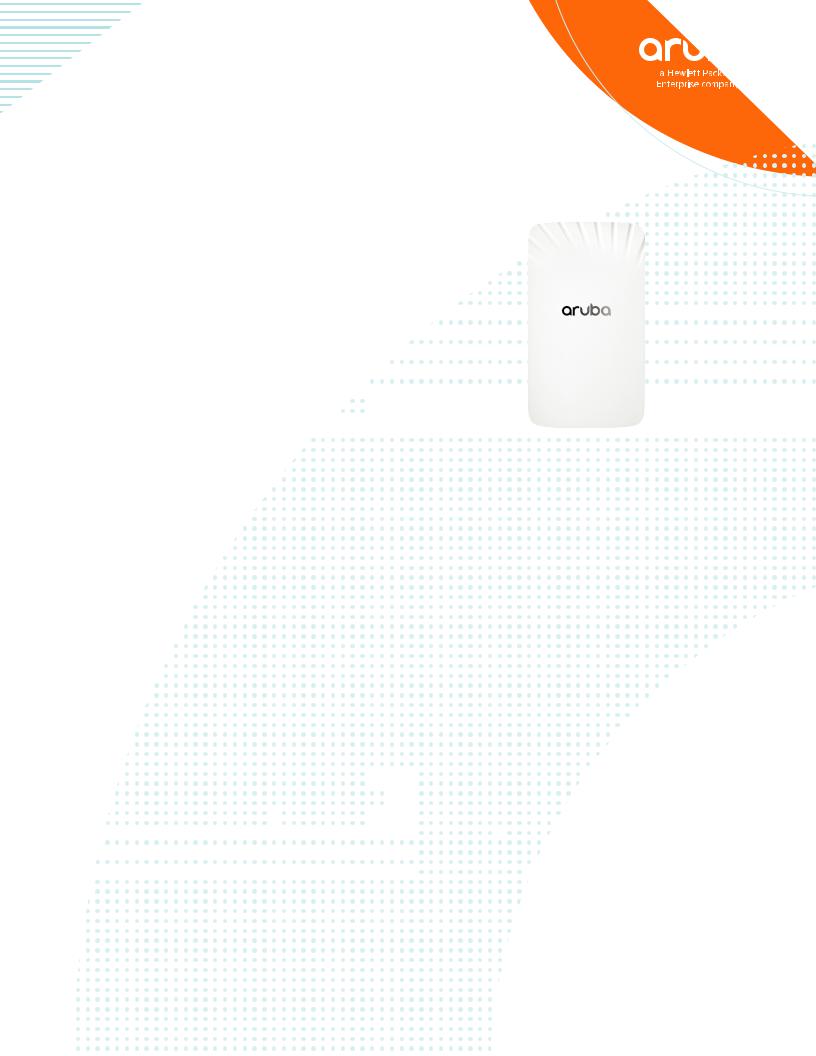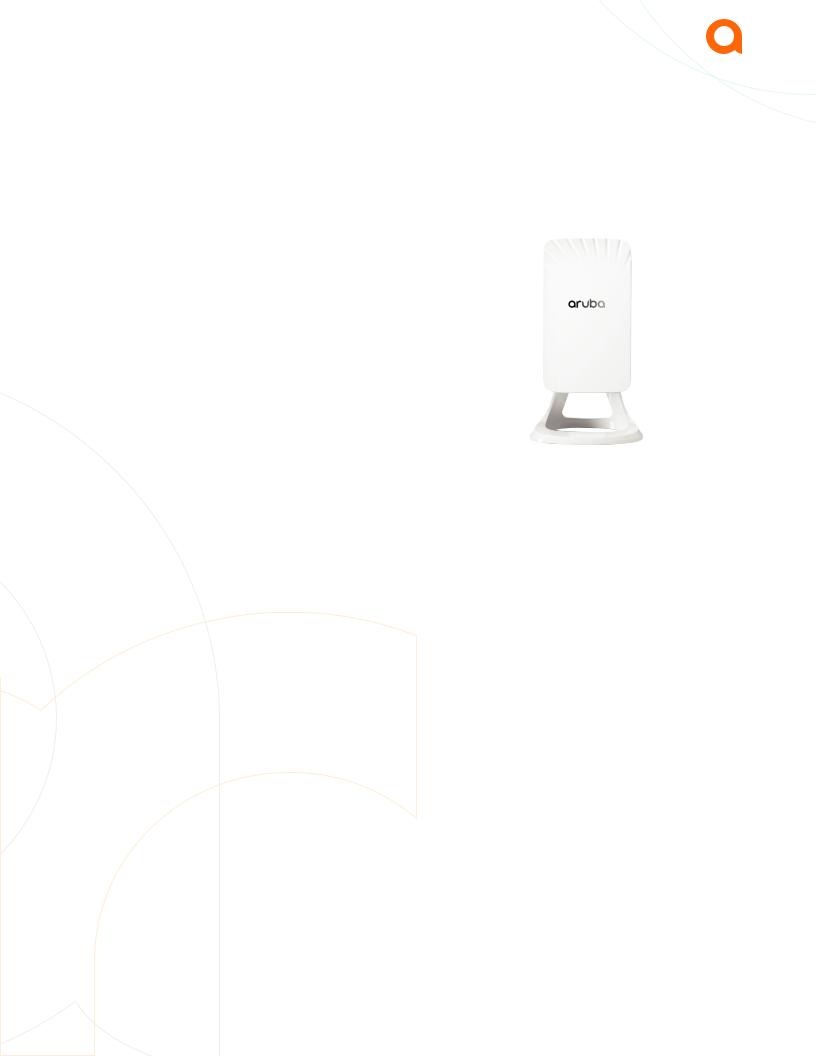Aruba AP-503H data sheet

DATA SHEET
ARUBA 500H SERIES
HOSPITALITY ACCESS
POINTS
High performance and cost-effective
Wi Fi 6 (802.11ax) for hospitality, branch, and teleworker deployments
These economical Wi-Fi 6 access points provide 




































 high performance connectivity for any organization
high performance connectivity for any organization 







































 experiencing growing mobile, cloud and IoT requirements.
experiencing growing mobile, cloud and IoT requirements. 









































 With a wireless aggregate data rate of up to 1.5 Gbps
With a wireless aggregate data rate of up to 1.5 Gbps 











































 and gigabit local wired ports, they deliver the range of
and gigabit local wired ports, they deliver the range of 













































 connectivity options needed for venues such as hotels,
connectivity options needed for venues such as hotels, 












































 residence halls, and remote offices alike.
residence halls, and remote offices alike. 


















































INCREDIBLE EFFICIENCY |
KEY FEATURES |
|
The 500H Series APs are designed to optimize user |
||
• Combine wireless and wired access in a single |
||
experience by maximizing Wi-Fi efficiency and dramatically |
||
compact form factor |
||
reducing airtime contention between clients. |
||
• Ideal for organizations with work from home or |
||
|
||
Features include Orthogonal frequency-division multiple |
teleworker initiatives |
|
access (OFDMA), multi-user MIMO and cellular optimization. |
• Up to 1.5 Gbps of maximum wireless throughput |
|
With up to 2 spatial streams (2SS) and 80MHz channel |
• 4 wired network ports and 1 Smart Rate uplink port |
|
bandwidth, the 500H Series provides groundbreaking |
• WPA3 and Enhanced Open security |
|
wireless capabilities for budget-conscious deployments. |
• Built-in technology that resolves sticky client issues |
|
Read the Multi-User 802.11ax white paper for further |
for Wi-Fi 6 and Wi-Fi 5 devices |
|
• OFDMA and MU-MIMO for enhanced multi-user |
||
information. |
||
efficiency |
||
Advantages of OFDMA |
||
• IoT-ready Bluetooth 5 and Zigbee support |
||
|
||
This capability allows Aruba’s APs to handle multiple Wi-Fi 6 |
|
|
capable clients on each channel simultaneously, regardless of |
|
|
|
||
device or traffic type. Channel utilization is optimized |
Wi-Fi 6 and MU-MIMO aware client optimization |
by handling each transaction via smaller sub-carriers or 



 Aruba’s patented AI-powered ClientMatch technology resource units (RUs), which means that clients are sharing a
Aruba’s patented AI-powered ClientMatch technology resource units (RUs), which means that clients are sharing a

 eliminates sticky client issues by placing Wi-Fi 6 capable channel and not competing for airtime
eliminates sticky client issues by placing Wi-Fi 6 capable channel and not competing for airtime and bandwidth.
and bandwidth. 



 devices on the best available AP. Session metrics are used
devices on the best available AP. Session metrics are used































 to steer mobile
to steer mobile devices to the best AP based on available
devices to the best AP based on available
































 bandwidth, types of applications being used and traffic type –
bandwidth, types of applications being used and traffic type – 































 even as users roam.
even as users roam.

DATA SHEET
ARUBA 500H SERIES HOSPITALITY ACCESS POINTS
Advanced Cellular Coexistence (ACC)
This feature uses built-in filtering to automatically minimize the impact of interference from cellular networks, distributed antenna systems (DAS), and commercial small cell or femtocell equipment.
Intelligent Power Monitoring (IPM)
Aruba APs continuously monitor and report hardware energy consumption. They can also be configured to enable or disable capabilities based on available PoE power – ideal when wired switches have exhausted their power budget (AP-505H).
IoT PLATFORM CAPABILITIES
Like all Aruba Wi-Fi 6 APs, the 500H Series includes an integrated Bluetooth 5 and 802.15.4 radio (for Zigbee support) to simplify deploying and managing IoT-based location services, asset tracking services, security solutions and IoT sensors. This allows organizations to leverage the 500H Series as an IoT platform, which eliminates the need for an overlay infrastructure and additional IT resources.
Target Wake Time (TWT)
Ideal for IoTs that communicate infrequently, TWT establishes a schedule for when clients need to communicate with an AP. This helps improve client power savings and reduces airtime contention with other clients.
Advanced IoT Coexistence (AIC)
This feature uses built-in filtering to allow Wi-Fi and BLE/
Zigbee radios to operate at maximum performance, range and capacity without the impact of mutual interference
ARUBA SECURE INFRASTRUCTURE
The Aruba 500H Series includes security components to help protect user authentication and wireless traffic. Select capabilities include:
WPA3 and Enhanced Open
Support for stronger encryption and authentication is provided via the latest version of WPA for enterprise protected networks. Enhanced Open offers seamless new protection
for users connecting to open networks where each session is automatically encrypted to protect user passwords and data on guest networks.
WPA2-MPSK
MPSK enables simpler passkey management for WPA2 devices – should the Wi-Fi password on one device or device type change, no additional changes are needed for other devices. This requires ClearPass Policy Manager.
VPN Tunnels
In Remote AP (RAP) and IAP-VPN deployments, the Aruba
500H Series can be used to establish a secure SSL/IPSec VPN tunnel to a Gateway or Mobility Controller that is acting as a
VPN concentrator.
Trusted Platform Module (TPM)
For enhanced device assurance, all Aruba APs have an installed TPM for secure storage of credentials, keys and boot code.
SIMPLE AND SECURE ACCESS
To simplify policy enforcement, the Aruba 500H Series uses Aruba’s Policy Enforcement Firewall (PEF) to encapsulate all traffic from the AP to the Mobility Controller (or gateway) for end-to-end encryption and inspection. Policies are applied based on user role, device type, applications, and location.
This reduces the manual configuration of SSIDs, VLANs and ACLs. PEF also serves as the underlying technology for Aruba
Dynamic Segmentation.
HIGH-DENSITY CONNECTIVITY
Each 500H Series AP provides connectivity for a maximum of 256 associated clients per radio (512 in total). In real-world scenarios, the maximum recommended client density is dependent on environmental conditions.
2

DATA SHEET
ARUBA 500H SERIES HOSPITALITY ACCESS POINTS
VERSATILE INSTALLATION OPTIONS
The APs can be deployed as a wall-mount or for remote teleworker environments, they can be converted to a deskmount by using an optional accessory stand.
FLEXIBLE OPERATION AND MANAGEMENT
A unique feature of Aruba APs is the ability to operate in either controller-less (Instant) or controller-based mode.
Controller-less (Instant) mode
In controller-less mode, one AP serves as a virtual controller for the entire network. Learn more about Instant mode in this technology brief.
Remote AP or IAP-VPN mode
For both cloud and on-premises deployments, each AP can establish secure overlay VPN tunnels to a VPN Concentrator (VPNC). Aruba Central-managed SD-WAN Gateways and on premises Mobility Controllers both support VPNC functionality.
Mobility Controller mode
For large installations across multiple sites, APs can be factory-shipped and can be activated with Zero Touch
Provisioning through Aruba Central or AirWave. This reduces deployment time, centralizes configuration, and helps manage inventory.
Access point with optional stand shown
For optimized network performance, roaming and security, APs tunnel all traffic to a mobility controller for centrally managed traffic forwarding and segmentation, data encryption, and policy enforcement. Learn more in the ArubaOS datasheet.
Management options
Available management solutions include Aruba Central (cloud-managed) or Aruba AirWave – a multi-vendor on premises management solution.
3

DATA SHEET
ARUBA 500H SERIES HOSPITALITY ACCESS POINTS
TECHNICAL SPECIFICATIONS
Hardware variants
AP type |
• AP-503H: Mid-range dual radio Wi-Fi 6 Hospitality AP with 1+2 Ethernet ports |
|
|
• AP-505H: High-end dual radio Wi-Fi 6 Hospitality AP with 1+4 Ethernet ports, PSE, USB |
|
|
|
|
Wi-Fi radio and platform specifications |
||
|
|
|
5GHz radio |
Two spatial stream (SU/MU) MIMO for up to 1.2Gbps wireless data rate (HE80) |
|
|
|
|
2.4GHz radio |
Two spatial stream (SU/MU) MIMO for up to 287Mbps wireless data rate (HE20) |
|
|
Note: HE40 operation is supported in 2.4GHz, but uncommon and not recommended for enterprise |
|
|
deployments |
|
|
|
|
Maximum number of |
Up to 256 associated client devices per radio |
|
associated client devices |
|
|
|
|
|
Maximum number of BSSIDs |
16 BSSIDs per radio |
|
|
|
|
Supported frequency bands |
• 2.400 to 2.500GHz (ISM) channels 1-13 |
|
(country-specific restrictions |
• 5.150 to 5.250GHz (U-NII-1) channels 36, 40, 44, 48 |
|
apply) |
• 5.250 to 5.350GHz (U-NII-2A) channels 52, 56, 60, 64 |
|
|
• 5.470 to 5.725GHz (U-NII-2C) channels 100, 104, 108, 112, 116, 120, 124, 128, 132, 136, 140, 144 |
|
|
• 5.725 to 5.850GHz (U-NII-3) channels 149, 153, 157, 161, 165 |
|
|
|
|
Dynamic frequency selection (DFS) optimizes the use of available RF spectrum |
||
|
|
|
Supported radio |
• 802.11b: Direct-sequence spread-spectrum (DSSS) |
|
• 802.11a/g/n/ac: Orthogonal frequency-division multiplexing (OFDM) |
||
technologies |
||
• 802.11ax: Orthogonal frequency-division multiple access (OFDMA) with up to 8 resource units |
||
|
||
|
|
|
|
• 802.11b: BPSK, QPSK, CCK |
|
Supported modulation types: |
• 802.11a/g/n: BPSK, QPSK, 16-QAM, 64-QAM, 256-QAM (proprietary extension) |
|
• 802.11ac: BPSK, QPSK, 16-QAM, 64-QAM, 256-QAM, 1024-QAM (proprietary extension) |
||
|
||
|
• 802.11ax: BPSK, QPSK, 16-QAM, 64-QAM, 256-QAM, 1024-QAM |
|
|
|
|
802.11n high-throughput |
HT20/40 |
|
(HT) support |
||
|
||
|
|
|
802.11ac very high |
VHT20/40/80 |
|
throughput (VHT) support: |
||
|
||
|
|
|
802.11ax high efficiency (HE) |
HE20/40/80 |
|
support: |
||
|
||
|
|
|
|
• 802.11b: 1, 2, 5.5, 11 |
|
|
• 802.11a/g: 6, 9, 12, 18, 24, 36, 48, 54 |
|
Supported data rates (Mbps): |
• 802.11n: 6.5 to 300 (MCS0 to MCS15, HT20 to HT40), 400 with 256-QAM |
|
• 802.11ac: 6.5 to 867 (MCS0 to MCS9, NSS = 1 to 2, VHT20 to VHT80), 1,083 with 1024-QAM |
||
|
||
|
• 802.11ax (2.4GHz): 3.6 to 574 (MCS0 to MCS11, NSS = 1 to 2, HE20 to HE40) |
|
|
• 802.11ax (5GHz): 3.6 to 1,201 (MCS0 to MCS11, NSS = 1 to 2, HE20 to HE80) |
|
|
|
|
802.11n/ac/ax packet |
A-MPDU, A-MSDU |
|
aggregation: |
||
|
||
|
|
|
Transmit power |
Configurable in increments of 0.5 dBm |
|
|
|
|
Maximum (aggregate, |
• 2.4 GHz band: +20 dBm (17 dBm per chain) |
|
conducted total) transmit |
• 5 GHz band: +21 dBm (18 dBm per chain) |
|
power (limited by local |
• Note: conducted transmit power levels exclude antenna gain. For total (EIRP) transmit power, add |
|
regulatory requirements): |
antenna gain |
|
|
||
|
|
|
Minimum configurable |
0dBm (conducted, per chain) |
|
transmit power level |
||
|
||
|
|
|
VPN IPsec throughput |
100 Mbps (AP-503H) and 500 Mbps or better (AP-505H) |
|
performance |
||
|
||
|
|
|
4
